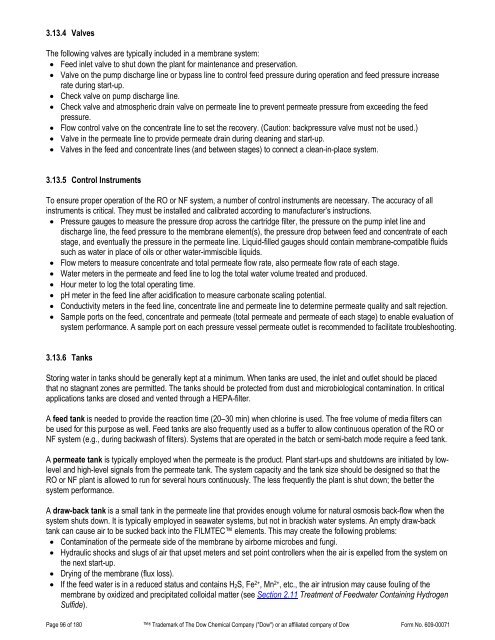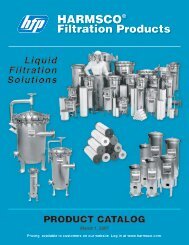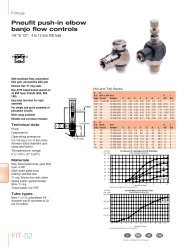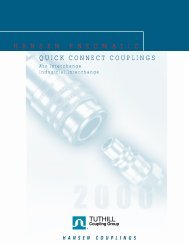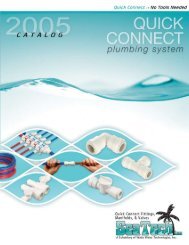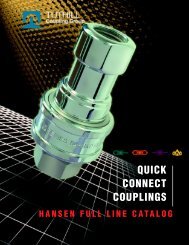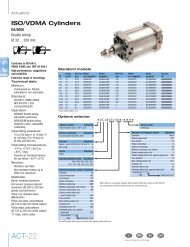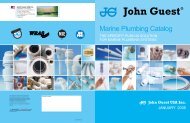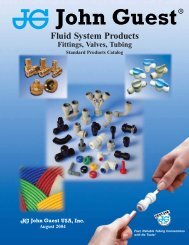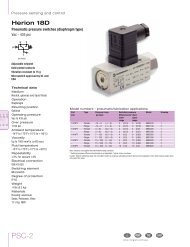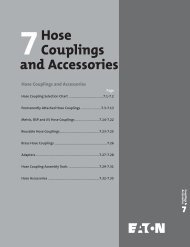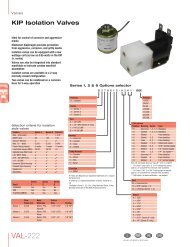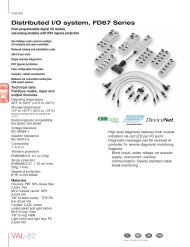FilmTec Technical Manual - Chester Paul Company
FilmTec Technical Manual - Chester Paul Company
FilmTec Technical Manual - Chester Paul Company
Create successful ePaper yourself
Turn your PDF publications into a flip-book with our unique Google optimized e-Paper software.
3.13.4 ValvesThe following valves are typically included in a membrane system:• Feed inlet valve to shut down the plant for maintenance and preservation.• Valve on the pump discharge line or bypass line to control feed pressure during operation and feed pressure increaserate during start-up.• Check valve on pump discharge line.• Check valve and atmospheric drain valve on permeate line to prevent permeate pressure from exceeding the feedpressure.• Flow control valve on the concentrate line to set the recovery. (Caution: backpressure valve must not be used.)• Valve in the permeate line to provide permeate drain during cleaning and start-up.• Valves in the feed and concentrate lines (and between stages) to connect a clean-in-place system.3.13.5 Control InstrumentsTo ensure proper operation of the RO or NF system, a number of control instruments are necessary. The accuracy of allinstruments is critical. They must be installed and calibrated according to manufacturer’s instructions.• Pressure gauges to measure the pressure drop across the cartridge filter, the pressure on the pump inlet line anddischarge line, the feed pressure to the membrane element(s), the pressure drop between feed and concentrate of eachstage, and eventually the pressure in the permeate line. Liquid-filled gauges should contain membrane-compatible fluidssuch as water in place of oils or other water-immiscible liquids.• Flow meters to measure concentrate and total permeate flow rate, also permeate flow rate of each stage.• Water meters in the permeate and feed line to log the total water volume treated and produced.• Hour meter to log the total operating time.• pH meter in the feed line after acidification to measure carbonate scaling potential.• Conductivity meters in the feed line, concentrate line and permeate line to determine permeate quality and salt rejection.• Sample ports on the feed, concentrate and permeate (total permeate and permeate of each stage) to enable evaluation ofsystem performance. A sample port on each pressure vessel permeate outlet is recommended to facilitate troubleshooting.3.13.6 TanksStoring water in tanks should be generally kept at a minimum. When tanks are used, the inlet and outlet should be placedthat no stagnant zones are permitted. The tanks should be protected from dust and microbiological contamination. In criticalapplications tanks are closed and vented through a HEPA-filter.A feed tank is needed to provide the reaction time (20–30 min) when chlorine is used. The free volume of media filters canbe used for this purpose as well. Feed tanks are also frequently used as a buffer to allow continuous operation of the RO orNF system (e.g., during backwash of filters). Systems that are operated in the batch or semi-batch mode require a feed tank.A permeate tank is typically employed when the permeate is the product. Plant start-ups and shutdowns are initiated by lowleveland high-level signals from the permeate tank. The system capacity and the tank size should be designed so that theRO or NF plant is allowed to run for several hours continuously. The less frequently the plant is shut down; the better thesystem performance.A draw-back tank is a small tank in the permeate line that provides enough volume for natural osmosis back-flow when thesystem shuts down. It is typically employed in seawater systems, but not in brackish water systems. An empty draw-backtank can cause air to be sucked back into the FILMTEC elements. This may create the following problems:• Contamination of the permeate side of the membrane by airborne microbes and fungi.• Hydraulic shocks and slugs of air that upset meters and set point controllers when the air is expelled from the system onthe next start-up.• Drying of the membrane (flux loss).• If the feed water is in a reduced status and contains H 2 S, Fe 2+ , Mn 2+ , etc., the air intrusion may cause fouling of themembrane by oxidized and precipitated colloidal matter (see Section 2.11 Treatment of Feedwater Containing HydrogenSulfide).Page 96 of 180 ® Trademark of The Dow Chemical <strong>Company</strong> ("Dow") or an affiliated company of Dow Form No. 609-00071


